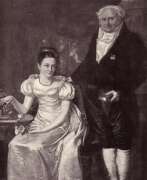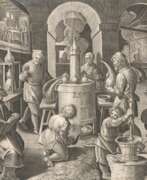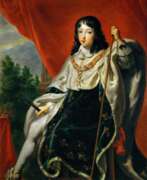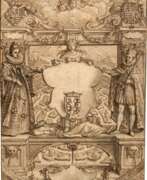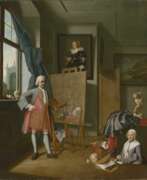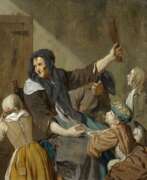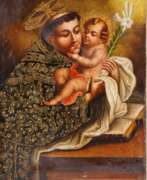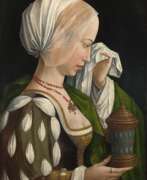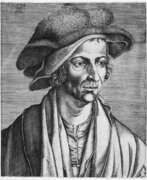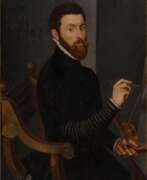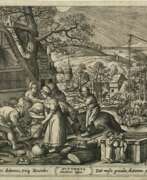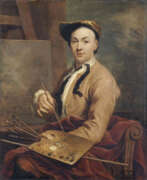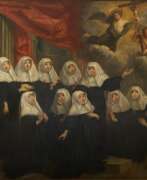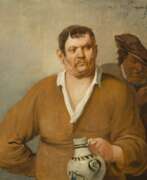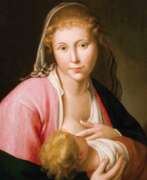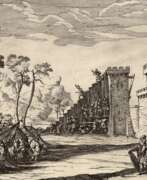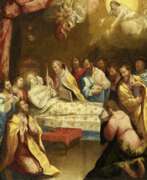Portrait Flanders
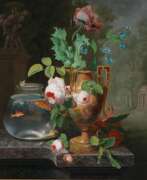

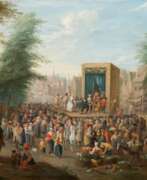

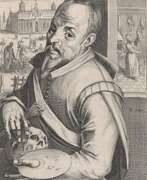

Joachim Beuckelaer, a masterful Flemish painter born around 1533, was renowned for his intricate market and kitchen scenes, which were abundant with detailed depictions of food and household items. His unique approach combined everyday life with religious narratives, often situating biblical episodes within the backdrop of bustling market scenes or domestic settings. This innovative blend of the mundane with the spiritual set the stage for future developments in Dutch and Flemish painting.
Beuckelaer's influence extended beyond his immediate geographic locale, impacting artists across Europe, from Italy to Spain, heralding a new appreciation for kitchen and market scenes that would flourish in seventeenth-century painting. His works were not only appreciated for their aesthetic and technical mastery but also for their ability to capture the essence of sixteenth-century Antwerp life, from the vibrancy of its markets to the intimacy of its kitchens.
His oeuvre includes a variety of subjects, from purely religious works to those that focus solely on still-life elements without any human figures, indicating his versatility and innovation as an artist. Beuckelaer was known for employing techniques that allowed him to efficiently reuse compositions, showcasing his ability to adapt and repurpose his work to meet the demands of his patrons.
Notable works by Beuckelaer, such as the "Four Elements" series, now housed in the National Gallery, London, demonstrate his skill in merging complex allegories with detailed observations from nature and daily life. These paintings are celebrated for their depth of detail and the way they foreground the role of women in the culinary and market spheres.
For collectors and experts in art and antiques, Joachim Beuckelaer's paintings offer a fascinating glimpse into the cultural and social dynamics of the sixteenth century, as well as the evolution of still-life and genre painting in the early modern period. His ability to weave together the secular and sacred, the abundant and the everyday, marks him as a significant figure in the history of art.
To remain informed about the latest discoveries, sales, and auction events related to Joachim Beuckelaer, consider signing up for updates. This subscription is an invaluable resource for those keen to explore the depths of Flemish painting and its enduring influence on European art history.
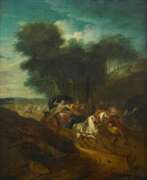

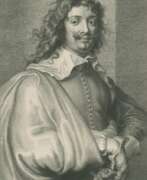

Adriaen Brouwer was a Flemish painter active in Flanders and the Dutch Republic in the first half of the 17th century. Brouwer was an important innovator of genre painting through his vivid depictions of peasants, soldiers and other "lower class" individuals engaged in drinking, smoking, card or dice playing, fighting, music making etc. in taverns or rural settings. Brouwer contributed to the development of the genre of tronies, i.e. head or facial studies, which investigate varieties of expression. In his final year he produced a few landscapes of a tragic intensity. Brouwer's work had an important influence on the next generation of Flemish and Dutch genre painters. Although Brouwer produced only a small body of work, Dutch masters Peter Paul Rubens and Rembrandt collected it.
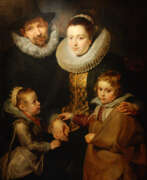

Jan Brueghel the Elder, a Flemish painter born in 1568 in Brussels, was a pivotal figure in the Baroque period known for his intricate landscapes, detailed still lifes, and genre scenes. The son of Pieter Bruegel the Elder, Jan was distinguished by his delicate brushwork, earning him the nicknames "Velvet" Brueghel, "Flower" Brueghel, and "Paradise" Brueghel, each reflecting a different aspect of his versatile artistic output. His monikers refer to his skill in rendering fabrics, his specialization in flower still lifes, and his creation of the paradise landscape genre, respectively.
After early training in Brussels, possibly under the guidance of his grandmother Mayken Verhulst, and further studies in Antwerp, Brueghel ventured to Italy, where he worked in Rome under the patronage of Cardinal Ascanio Colonna and met influential artists like Paul Bril. His Italian sojourn greatly influenced his style, especially in landscape painting. Upon returning to Antwerp, he established a flourishing workshop and became a master in the Guild of St. Luke. Brueghel's collaborations with Peter Paul Rubens are among the most celebrated in art history, showcasing a harmonious blend of landscape and figure painting.
Jan Brueghel the Elder's works are prized for their vibrant depiction of nature and meticulous attention to detail. His landscapes are not just backdrops but are lively settings filled with rich narratives and a variety of creatures, reflecting his deep appreciation for the natural world. His flower pieces are equally renowned for their variety and realism, often serving as allegorical or symbolic representations.
Brueghel's legacy extends beyond his paintings; he was a pivotal figure in the Antwerp artistic community, serving as dean of the Guild of St. Luke and court painter to the Archduke Albert of Austria and the Infanta Isabella Clara Eugenia of Spain. His influence continued through his children, with his son Jan Brueghel the Younger continuing his workshop and maintaining the family's artistic traditions.
For collectors and experts in art and antiques, Jan Brueghel the Elder's works represent a high point in Flemish Baroque art, offering a glimpse into the era's aesthetic values and the artist's profound observation of the world around him. His paintings, found in museums and galleries worldwide, continue to captivate audiences with their beauty and depth.
To stay informed about new discoveries, sales, and auction events related to Jan Brueghel the Elder's work, consider signing up for updates. This subscription will ensure that you are always in the know about opportunities to engage with the enduring art of this Flemish master.
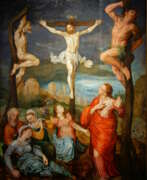

Raphael Coxie was a Flemish Renaissance painter mainly known for his portrait and history paintings. Details about the life and career of the artist are sketchy. He was only rediscovered as a distinctive artist in the 19th century. He was a pupil of his father and became master in the Mechelen Guild of Saint Luke in 1562. Raphael was a passionate gardener and friend of the Flemish botanist Carolus Clusius to whom he sent drawings of flowers, which Clusius used in his scientific publications. He was active from 1586 in Brussels where he became a master of the local painter's guild in 1605. In the period 1588-89 he spent time in Ghent on a major commission for a painting of the Last Judgement. While in Ghent Coxie also painted a Resurrection of Christ for the monks of the Abbey of Drongen. He is recorded in 1597 as making, in collaboration with Gilbert van Veen, several portraits commissioned by Philip II of Spain.
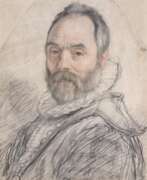

Giovanni da Bologna, also known as Jean de Boulogne (French), Giambologna (Italian), Fiammingo (Italian) and Jehan Boulongne (Flemish), was the last significant Italian Renaissance sculptor, with a large workshop producing large and small works in bronze and marble in a late Mannerist style.
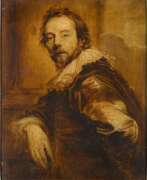

Adam de Coster, born around 1586 in Mechelen and passing away in 1643 in Antwerp, was a renowned Flemish painter and a key figure among the Antwerp Caravaggisti. This group of artists was part of an international movement that interpreted Caravaggio's work in a personal manner, known for their genre scenes with strong chiaroscuro effects. De Coster was particularly celebrated for his nocturnal scenes, earning him the nickname "Pictor Noctium" (literal translation „Painter of Nights“) due to his preference for tenebrist scenes.
His works often depicted subjects similar to those found in Caravaggio's paintings, such as card sharps, fortune tellers, and musical performances, showcasing de Coster's fascination with the play of light and shadow. Notable pieces by de Coster include "Three Singers," which demonstrates his skill in rendering the texture of fabrics and the dramatic effects of light on his subjects, and "A Man Singing by Candlelight," capturing a moment's drama through meticulous lighting.
Adam de Coster's art continues to captivate audiences with its atmospheric intensity and meticulous attention to detail. His contributions have solidified his place in the history of Flemish painting, with works featured in prestigious collections, including the Liechtenstein Museum in Vienna and the National Gallery of Ireland.
For collectors and experts in art and antiques, Adam de Coster's masterpieces represent a fascinating intersection of Flemish tradition and Caravaggesque innovation. To stay informed about new discoveries, sales, and auction events related to Adam de Coster, consider signing up for updates from art galleries and auction houses. This will ensure you have access to the latest information and opportunities to appreciate the legacy of this luminous master of painting.
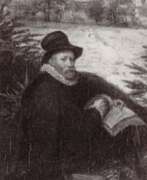

Lucas van Valckenborch was a Flemish painter, mainly known for his landscapes. He also made contributions to portrait painting, and allegorical and market scenes. Court painter to Archduke Matthias, the governor of the Spanish Netherlands in Brussels, he later migrated to Austria and then Germany where he joined members of his extended family of artists who had moved there for religious reasons.
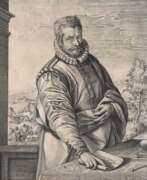

Philips Galle was a Dutch publisher, best known for publishing old master prints, which he also produced as designer and engraver. He is especially known for his reproductive engravings of paintings.
As a resident of Antwerp, Galle witnessed numerous events of the Eighty Years War, notably the siege and looting of the town in 1576 by the Spaniards, called "The Spanish Fury". This rather personal book, which was translated in several languages soon after its first publication, shows Galle as a peace-loving person who intended to stay far away from the political and military turmoil of his era.
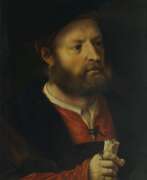

Jan Gossaert was a French-speaking painter from the Low Countries also known as Jan Mabuse (the name he adopted from his birthplace, Maubeuge) or Jennyn van Hennegouwe (Hainaut), as he called himself when he matriculated in the Guild of Saint Luke, at Antwerp, in 1503. He was one of the first painters of Dutch and Flemish Renaissance painting to visit Italy and Rome, which he did in 1508–09, and a leader of the style known as Romanism, which brought elements of Italian Renaissance painting to the north, sometimes with a rather awkward effect. He achieved fame across at least northern Europe, and painted religious subjects, including large altarpieces, but also portraits and mythological subjects, including some nudity.
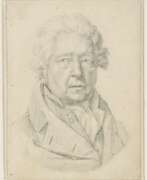

Willem Jacob Herreyns, the Younger, was a Flemish painter of history subjects and portraits. He is regarded as one of the last painters in the tradition of the Flemish Baroque and the last follower of Peter Paul Rubens. Herreyns’ work was very highly regarded in his time. His religious compositions stand in the Rubens tradition. Herreyns is considered a draughtsman with a precise line, but his work shows a certain coldness and lacks originality.
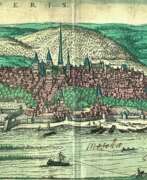

Frans Hogenberg was a Flemish and German painter, engraver, and mapmaker. He is known for portraits and topographical views as well as historical allegories. He also produced scenes of contemporary historical events. Hogenberg was the author of graphic works, engravings of city views and maps of the first four volumes of the six-volume atlas Theatrum Orbis Terrarum (Description and drawings of the most famous cities in the world), published in 1570 by the Flemish geographer Abraham Ortelius. Hogenberg's engravings are an invaluable source of information about urban development in medieval Europe.
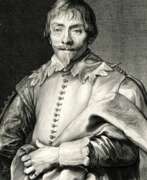



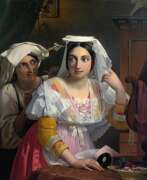

Jan Baptist Lodewyck Maes was a Belgian genre painter active in Italy. Maes studied at the Academy of Ghent. He exhibited for the first time at that city's fair in 1810. He won prizes in all the competitions he entered and in 1820 received a grant from the city of Ghent. Thanks to the Belgian Rome Prize received in 1821, he first visited Paris and then went on to Italy. In 1822 he copied works by old masters in the Uffizi Museum. In 1824 he settled in Rome. Maes kept in touch with his hometown and regularly sent works to Belgian salons. He was a corresponding member of the Royal Netherlands Academy of Sciences.
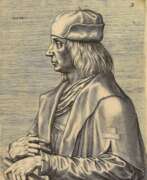

Quentin Matsys (Dutch: Quinten Matsijs), a Flemish painter born around 1466 in Leuven, is recognized as a pivotal figure in the Early Netherlandish tradition and a founder of the Antwerp school of painting. His initial training as an ironsmith in his father's workshop lent a unique craftsmanship to his artistic endeavors. Matsys' works, which often contained religious themes and satirical elements, were instrumental in the transition from medieval to Renaissance art in northern Europe.
Matsys' early works exhibit the influence of Hans Memling, and later, his exposure to Italian Renaissance artists, especially Leonardo da Vinci, is evident in his refined technique. This amalgamation of Northern European and Italian influences resulted in a distinctive style that earned him the reputation as the leading painter in Antwerp during the early 16th century.
Today, Matsys' masterpieces are housed in prestigious institutions like the National Gallery in London, serving as a testament to his enduring legacy. His contributions to the art world resonate with collectors and historians alike, who admire his innovative blend of technical skill and evocative expression.


Livio Mehus, née Lieven Mehus, was a Flemish and Italian Baroque painter, draughtsman, and printmaker.
Mehus lived and worked most of his life in Florence, painting allegories, battle scenes and landscapes, portraits and self-portraits.
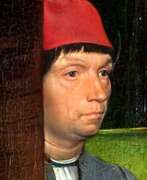

Hans Memling (German Hans Memling, Dutch Jan van Mimmelynghe, Latin Johannes Memmelinc or Memlinc) is a Flemish painter of German origin, one of the most important artists of Flanders of the Northern Renaissance. Continuing the late Gothic painting tradition, Memling primarily painted spiritual themes. Born in Hesse, he worked mainly in Bruges, where today there is a museum named after him.
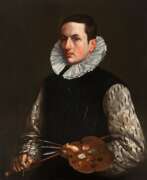

Frans Pourbus the Elder was a Flemish Renaissance painter born in 1545 in Bruges, known for his portraiture and religious compositions, as well as a few genre scenes. He inherited a rich artistic legacy as the son of the painter Pieter Pourbus and the father of Frans Pourbus the Younger, an internationally recognized portraitist.
Pourbus’ art is celebrated for its meticulous detail and psychological depth, particularly in his portraits which primarily featured members of the rising middle class, high clergy, local aristocrats, and foreign dignitaries. His acute observational skills and subtle modeling of facial features provided a vivid psychological insight into his sitters, as seen in the Portrait of an Unknown Man.
His religious works were often commissioned by patrons outside Antwerp and included significant projects like the History of Saint Andrew and the Triptych of Viglius Aytta for St Bavo's Cathedral in Ghent. After the Iconoclastic Fury in 1566, he received a prestigious commission to redecorate the choir of the St. Martin's Abbey church in Tournai.
Pourbus’ works are held in high esteem and can be found in several museums and galleries, such as the National Galleries of Scotland and The National Gallery in London, where his pieces continue to draw the admiration of art collectors and experts in the field.
For enthusiasts and experts in Renaissance art and those interested in the intricate craft of portrait painting, Frans Pourbus the Elder’s work stands as a significant reference point for the cultural and artistic achievements of the period. To remain updated on sales and auction events related to Frans Pourbus the Elder, art collectors and antiques experts are encouraged to sign up for updates. This will ensure that you are always informed about new opportunities to acquire works by or related to this master artist.
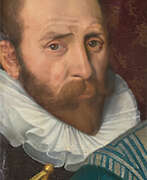

Frans Pourbus the Younger was a Flemish artist, renowned for his sophisticated portraiture, who gained prominence for his meticulous depiction of opulent costumes, jewelry, and drapery. Born in Antwerp in 1569 into a family with a rich artistic lineage, Pourbus honed his craft in the vibrant cultural milieu of the time. His grandfather, Pieter Pourbus, was a leading portrait and history painter in Bruges, while his father, Frans Pourbus the Elder, was a significant figure in portrait and genre painting. The younger Pourbus’s artistry was characterized by its attention to detail rather than the exploration of dramatic scenes or landscapes, a style that resonated with the sensibilities of the courts he served.
Pourbus's career flourished as he became a court painter to influential figures such as Archduke Albert and Infanta Isabella in Brussels. His reputation for producing portraits that were aesthetically pleasing to his patrons propelled him to work for Vincenzo Gonzaga, Duke of Mantua, and subsequently, Marie de' Medici, Queen of France, in Paris. His works are preserved in prestigious collections across Europe, including the Louvre, the Prado, the Rijksmuseum, and the Metropolitan Museum of Art. Notable pieces such as the portrait of Eleonora de' Medici Gonzaga and the Infanta Isabella Clara Eugenia of Spain exemplify his skill in capturing the grandeur of the European aristocracy of the 17th century.
Art collectors and antiquities experts who admire the grandiose style of early European court portraiture find in Pourbus's work a quintessential representation of the era's aesthetics. His paintings, replete with detailed costume and adornment, provide a window into the past's lavishness and serve as enduring artifacts of cultural heritage. For updates on new product sales and auction events related to Frans Pourbus the Younger, signing up for our newsletter is a discreet and direct way to stay informed.
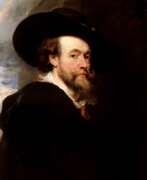

Peter Paul Rubens was a distinguished Flemish Baroque painter, renowned for his dynamic, vibrant, and sensuous paintings. Born on June 28, 1577, in Siegen, Westphalia, Germany, Rubens' family moved back to Antwerp in the Spanish Netherlands (now Belgium) after his father's death. He was raised in his mother’s Roman Catholic faith and received a classical education. He began his artistic training in 1591 and later traveled to Italy, where he was profoundly influenced by Renaissance masters like Titian, Tintoretto, and Veronese. This experience significantly shaped his artistic style.
Rubens' art is celebrated for its emphasis on movement, color, and sensuality. He was particularly skilled in depicting religious and mythological scenes, portraits, and landscapes. Some of his notable works include "The Descent from the Cross" and "The Raising of the Cross," which are prime examples of Baroque religious art, showcasing his unique style that blended influences from Italian Renaissance and his own innovations.
Rubens was not just a painter but also a diplomat, serving at various European courts. He was knighted by both Philip IV of Spain and Charles I of England. His diplomatic missions often intertwined with his artistic endeavors, as seen during his travels to Spain and Italy. In addition to painting, he was involved in designing tapestries, prints, and book title-pages. He ran a large workshop in Antwerp, producing works that were popular with nobility and art collectors across Europe. His studio was in his home, the Rubenshuis, now a museum.
His influence extended to his students, notably Anthony van Dyck, and his collaborative works with other artists like Jan Brueghel the Elder. Rubens' work continued to be celebrated for its vitality and influence on the Baroque style, making him one of the most influential artists of his time.
For those interested in the work and life of Peter Paul Rubens, many of his works can be found in museums and galleries worldwide, including the National Gallery in London, which houses several of his paintings like "A View of Het Steen in the Early Morning" and "Minerva protects Pax from Mars ('Peace and War')".
To stay updated on new product sales, auction events, and more related to Peter Paul Rubens, sign up for our updates. We provide essential information tailored for collectors and experts in art and antiques, focusing on the magnificent work of Rubens and his enduring legacy in the world of art.
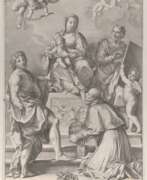

Robert van Audenaerde or Ouden-Aerd was a Flemish painter and engraver. He was first a scholar of Francis van Mierhop, but he afterwards studied under Hans van Cleef. When he was twenty-two years of age he went to Rome, where he became a disciple of Carlo Maratti. Under this master he became a good painter of historical subjects. He amused himself with the point in his leisure moments, and some of his plates were shown to Carlo Maratti, who recommended him to devote himself entirely to the art of engraving. He, however, painted several pictures for the churches of his native city, to which he returned after an absence, it is said, of thirty-seven years. The plates which he executed entirely with the graver are not considered equal to those in which he introduced the point. His drawing shows a perfect acquaintance with the human figure, and is very correct. The principal part of his prints are after the pictures of Carlo Maratti.


Joos van Cleve, also known by his real name Joos van der Beke, was a prominent Netherlandish painter, active mainly in Antwerp from about 1511 until his death in 1540 or 1541. His work predominantly centered around religious subjects and portraits, including notable commissions for the French King Francis I during his time at the French court. His artistic oeuvre reflects a blend of traditional Netherlandish painting techniques with contemporary Renaissance styles, showcasing his direct knowledge of local art combined with an awareness of Italian developments.
Van Cleve's work was characterized by its elaborate detail, particularly in his altarpieces which often incorporated portraits and landscapes, demonstrating his refined painting style. His success in Antwerp was significant, and he was also recognized at the French court, indicating his high regard as a portrait artist. Notably, Van Cleve had the opportunity to paint members of the royal court, including King Francis I and Queen Eleanor of Austria, underscoring his skills in portraiture.
His paintings are recognized for their sensitivity to color and a unique solidity of figures, with some works showcasing the popular style of Antwerp Mannerism. Van Cleve was an innovator in introducing broad world landscapes in the backgrounds of his paintings, a technique that became popular in sixteenth-century northern Renaissance paintings. Despite his contributions to the Renaissance art movement, Van Cleve also produced works that were highly eclectic, drawing on the styles of earlier Netherlandish masters as well as Italian influences, particularly in his use of sfumato, evident in his Virgin and Child compositions.
For art collectors and experts, Joos van Cleve's legacy offers a rich exploration into the transition from medieval to Renaissance art in Northern Europe. His body of work, found in prestigious collections such as the National Gallery in Prague, the Louvre, and the Royal Museums of Fine Arts of Belgium, remains a testament to his versatility and skill as a painter of both religious narratives and royal portraits.
To delve deeper into the fascinating world of Joos van Cleve and to stay informed about exhibitions or sales featuring his work, consider signing up for updates from art institutions and auction houses. This subscription will ensure you remain at the forefront of developments and opportunities related to this influential artist's oeuvre, enhancing your collection and understanding of Renaissance art.
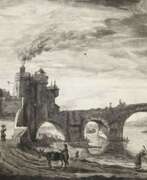

Jacob van der Heyden was a Flemish Baroque painter, sculptor and engraver. According to Houbraken he was a painter from Strasbourg who painted for royalty. According to the RKD he worked in Strasbourg, Frankfurt, and Sweden. and was known for portraits, landscapes and historical allegories. Most of his work that survives today are engravings. He died in Brussels.
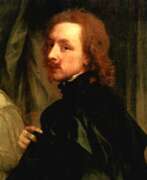

Anthony van Dyck, a Flemish painter born in 1599 in Antwerp and passed away in 1641 in London, is celebrated as one of the foremost Baroque painters of the 17th century. His notable contributions to the art world include his exceptional portraits of European aristocracy, as well as his religious and mythological paintings. Van Dyck's early exposure to art was influenced significantly by his apprenticeship with Hendrik van Balen and later, by the profound impact of working alongside Peter Paul Rubens. His mastery was recognized early on, leading him to set up his own workshop by the age of 15.
Van Dyck's journey to Italy in 1621 marked a pivotal phase in his career, allowing him to immerse himself in studying the Italian masters and commencing his successful stint as a portraitist. His style evolved under the influence of Titian, evident from his vibrant use of color and refined modeling of form. Van Dyck's Italian period not only honed his artistic skills but also established his reputation as a painter of consequence.
Upon returning to Antwerp, van Dyck's portraits became highly sought after, leading to commissions from notable figures such as Archduchess Isabella and Queen Mother Maria de' Medici. His role as a court painter further solidified in England under the patronage of King Charles I, where he was knighted and appointed as the principal painter, profoundly shaping the aristocratic character of Charles I's reign through his portraits.
Van Dyck's legacy extends beyond his death, having influenced English portrait painting for over a century. His innovative techniques in watercolour and etching, along with his sophisticated portrayal of subjects, continue to be admired. His art not only showcases his technical prowess but also reflects the cultural and social nuances of his era, making his work a significant study for collectors and art historians alike.
For enthusiasts eager to explore the intersections of art, history, and culture through the lens of Anthony van Dyck's work, staying informed about new discoveries and auction events is essential. Signing up for updates can provide exclusive insights into the world of one of the most influential figures in Flemish art. This subscription ensures that collectors and experts are well-informed of any developments related to van Dyck's oeuvre, enhancing their understanding and appreciation of his contributions to the art world.
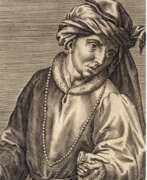

Jan Van Eyck, a prominent figure in the realm of art, was a Flemish painter renowned for his pioneering role in the development of oil painting. Born before 1395 in Maaseik, now Belgium, Van Eyck's work signifies a pivotal moment in the Early Netherlandish painting movement, contributing substantially to the Northern Renaissance's flourishing. His employment as court painter to Philip the Good, Duke of Burgundy, allowed him engagements that ranged from diplomatic missions to producing commissioned portraits, demonstrating his versatility beyond the canvas.
Van Eyck's mastery in oil painting brought to life detailed, realistic depictions of both secular and religious subjects, with a notable emphasis on naturalistic textures and light. His technique involved layering translucent oil paints to achieve an unmatched depth and vibrancy, a method that influenced generations of artists to come. Among his approximately twenty surviving works, the Ghent Altarpiece stands out as a monumental piece, showcasing his adept use of oil paint to create intricate details and luminous colors. Despite some debate over his brother Hubert's involvement, Jan's contribution to its creation is undisputed, cementing his legacy as a key figure in art history.
In addition to the Ghent Altarpiece, Van Eyck is celebrated for the Arnolfini Portrait, a work famed for its complex symbolism and innovative use of mirror reflection to incorporate the viewer into the scene. This painting, along with others like the Portrait of a Man (Self Portrait?), highlights Van Eyck's skill in creating vivid, textured surfaces that mimic the real world, blurring the lines between art and reality.
For collectors and experts in art and antiques, Van Eyck's oeuvre represents a crucial chapter in the evolution of Western art, offering insights into the cultural and technological advancements of his time. His works, preserved in some of the world's leading museums, continue to attract admiration for their technical brilliance and aesthetic beauty.
If you're intrigued by the innovation and mastery of Jan Van Eyck, consider signing up for updates on new product sales and auction events related to his work. This subscription offers a unique opportunity to stay informed about the latest discoveries and offerings in the realm of Van Eyck's enduring legacy.


Jan van Hemessen was a leading Flemish Renaissance painter, belonging to the group of Italianizing Flemish painters called the Romanists, who were influenced by Italian Renaissance painting. Van Hemessen had visited Italy during the 1520s, and also Fontainebleau near Paris in the mid 1530s, where he was able to view the work of the colony of Italian artists known as the First School of Fontainebleau, who were working on the decorations for the Palace of Fontainebleau. Van Hemessen's works show his ability to interpret the Italian models into a new Flemish visual vocabulary.
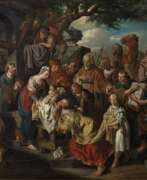

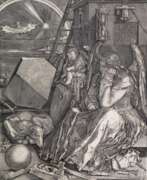

Johannes (Jan) Wierix was a Flemish engraver, draughtsman, and publisher. He was a very accomplished engraver who made prints after his own designs as well as designs by local and foreign artists.
Together with other members of the Wierix family of engravers he played an important role in spreading appreciation for Netherlandish art abroad as well as in creating art that supported the Catholic cause in the Southern Netherlands. Johannes Wierix is also known for his miniature pen drawings.
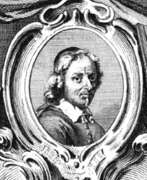

Peter Ykens (also spelled Pieter Eijckens, Eyckens and Eykens) was a Flemish Baroque painter and a member of the Guild of St. Luke.
His father was the painter and sculptor Johannes Ykens (1613-1680), who taught his son to paint. In time, Peter began to receive commissions to paint altars in Antwerp and Mechelen, creating many altarpieces. Peter Ykens also painted portraits, including a portrait of King Charles II of Spain, and paintings on historical subjects, made designs for tapestries, and collaborated with landscape and still life painters.
In 1689, Peter Ykens was elected dean of the Guild of St. Luke. He trained about 30 apprentices; his eldest son Jan Frans also became an artist.
